|
|
 |
| HOME |
 |
Research |
 |
Research Overview |
|
| |
| |
|
| 1) Organic-based Electronic Materials |
|
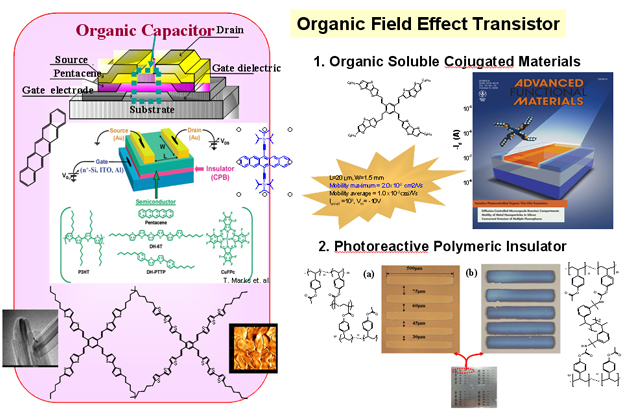 |
|
The rapid progress in the development of novel p-type organic semiconductors has resulted in high-performance organic thin film transistors (OTFTs) showing high hole mobilities-of the order of 1 cm2/V s. p-Type organic semiconductors, namely, derivatives of pentacene, rubrene, anthracene, or thiophene, have attracted a great deal of attention for applications in high-performance OTFTs. However, the deposition methods for the thin films of these molecules-under vacuum or inert atmospheric conditions-suffer severe limitations during large-scale device fabrication, due to the complexity of the process.
Organic semiconductors that are soluble in organic solvents facilitate the use of conventional low-cost spin-coating or drop-casting techniques for OTFT device fabrication In this paper, we present two different X-shaped conjugated molecules and demonstrate a promising new class of medium-sized molecules for OTFTs. We develop new semiconducting materials for active layer and dielectric materials for gate insulator in OTFT. Their characteristics of nano-objects are also being explored.
|
|
|
| |
| |
|
| 2) Photovoltaic Cell (OPV) |
|
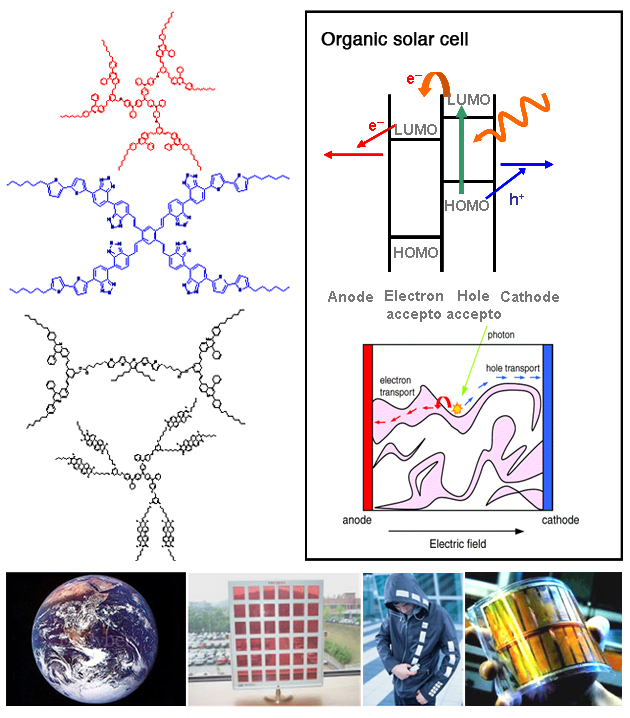 |
|
Organic semiconductor materials based on extended linear p-conjugated systems are very intriguing and, over the past one decade, have been the focus of much development. Similarly, much progress has also been made in the exploration of organic semiconductors as active elements in electronic devices, such as light emitting diodes (LEDs), thin-film transistors (TFTs), and solar cells . With regard to the application of organic semiconductors in electronic and optoelectronic devices, the organic photovoltaic (OPV) cell in particular is an important device in the development of future energy resources.
We develop new semiconducting materials for photoactive layer and fabricate polymer solar cell and ordered molecular solar cell. Their characteristics of bulk heterojunction and molecular heterojunction are being investigated. |
|
|
| |
| |
|
| 3) ORGANIC LIGHT EMITTING DIODES |
|
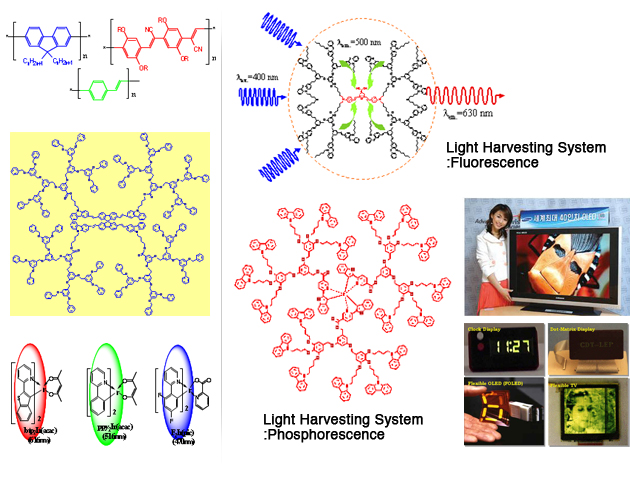 |
|
Of the various kinds of light-emitting organic materials available, phosphorescent materials have already been recognized as the best candidates, because both singlet and triplet excitons can generate unique light emissions, with a theoretical internal quantum efficiency of 100% . In particular, cyclometalated Ir(III) complexes show high phosphorescent efficiencies and are one of the most promising classes of phosphorescent dyes used in organic light emitting diodes (OLEDs). Along with the advancements in processing solutions for the fabrication of OLEDs, new highly soluble materials displaying fluorescent/phosphorescence have been reported recently.
We develop new fluorescent and phosphorescent materials for emitting layer and fabricate multilayered PLED (OLED) devices with the various auxiliary layers. Their device characteristics are being investigated.
It was also investigated to explore a method for tuning the emission color by using the new molecular design. |
|
|
| |
| |
|
| 4) Nanobiophotonics |
|
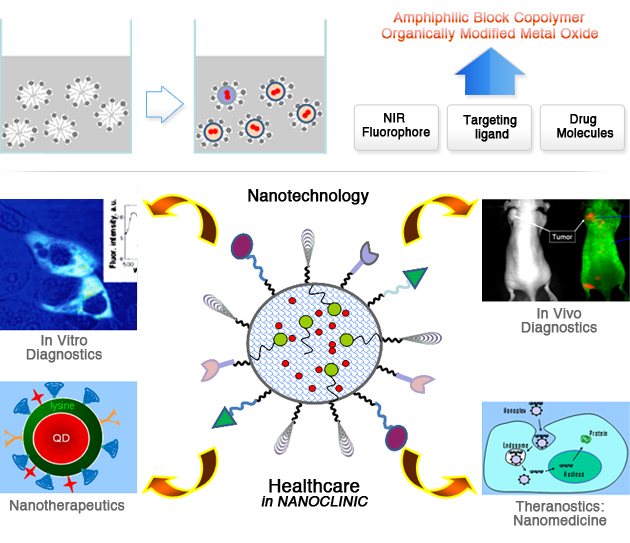 |
|
Nanotechnology is helping fields like imaging, diagnosis, drug delivery, regenerative medicine and biomaterials as well as underpinning the development of new generations of medical products. Many of these advances will offer vastly improved outcomes for patients, therapies for hitherto difficult-to-treat diseases or conditions, improved manufacturing efficiency, or better use of valuable medical professional resources. We are very interested in nanomedicine and nanotheranostics based on the science and technology of nanobiophotoncis..
To develop nano-sized molecular carriers and drug delivery systems, we develop the new technology to prepare the functional nanoparticles bearing near-infrared fluorescent dyes. The size of nanoparticle can provide some level of targetting such as drug delivery into cells, gene therapy, and cancer therapy. |
|
|
| |
| |
|
| 5) Electronic and Photonic Properties of Modified DNAs |
|
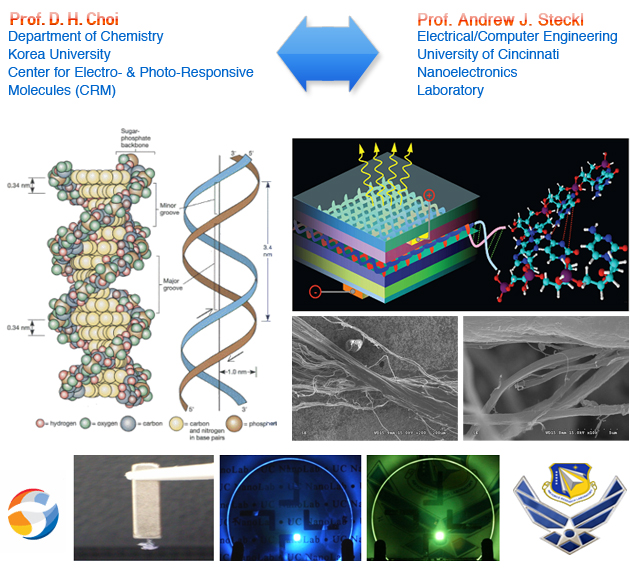 |
|
DNAs are among the oldest naturally occurring polymers and have a history that goes back to when the first primitive life forms came into existence. Since that time, DNA science has not only been the center of life science but also of current bioscience and biotechnology.
More recently, the unique nanostructure and replication properties of DNA molecules have been investigated by physical scientists interested in incorporating these properties into new devices. Biological polymeric materials are a widely available resource, and they are biodegradable and environmentally friendly. When introducing functional dye molecules into double-stranded (ds) DNA, the binding mode can help impose a site isolation effect, thereby preventing dye aggregation at high concentrations. The most interesting report relates to the fact that DNA is an efficient host for certain luminescent organic and organometallic fluorescent molecules in both solution and solid-state thin films. In our group, we synthesized modified functional DNAs that is soluble in organic solvents. We studied energy transfer behavior betweendonor and acceptor DNAs. We utilized carbazole-based PVK for electrophosphorescent devices. First the negative DNA photoresist was employed for gate insulator of thin film transistors. |
|
|
| |
| |
|
| 6) Holographic Materials |
|
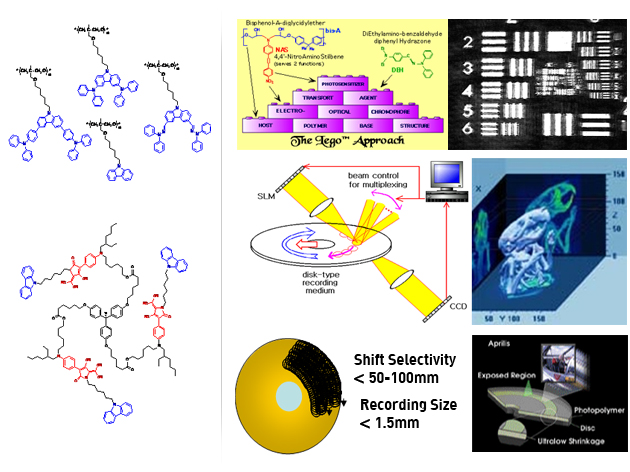 |
|
Photorefractive polymer composites or amorphous molecular glasses possessing large index modulation and high light sensitivity in the near-infrared (NIR) wavelength region were developed for various photonic applications. These materials show high sensitivity when used as a holographic recording media; thus, they may be useful for biological imaging technology.
Several organic amorphous glasses exhibited very outstanding photorefractive performance in the NIR range. Some of multifunctional materials do not require a plasticizer and exhibit considerable two beam coupling (2BC) gains and diffraction efficiencies even without the addition of a photosensitizer. We prepared a new star-shaped molecule bearing carbazole and a tricyanopyrroline (TCP)-based NLO chromophore in a peripheral arm. |
|
|
| |
| |
|
| 7) Nonlinear Optical Materials |
|
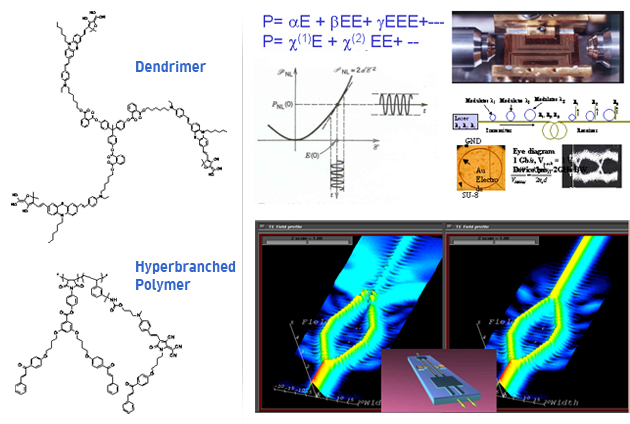 |
|
Both organic nonlinear optical active chromophores and polymeric composites have drawn considerable attention over the past two decades. Polymeric materials have strong potential for use in telecommunications, digital signal processing, phased array radar, THz generation, and many other applications as active materials in photonic micro-devices. Organic NLO material systems are advantageous because of factors such as high NLO susceptibility, fast response time, low dielectric constant, small dispersion in the refractive index, structural flexibility, and ease of material processing.
To achieve good device functionality, the NLO chromophore has to possess the following criterion simultaneously: high microscopic molecular nonlinearity, good thermal stability and photostability, low absorption, and weak molecular electrostatic interaction in the polymer matrix. However, there is still a strong need to improve the thermal stability of these materials in order to fulfill the requirements for multilayer fabrication processes and long-term device operation. To achieve this, the thermal crosslinking reaction was adopted for stabilizing the bulk acentric ordering of the NLO molecular lattice.
In order to overcome the commonly observed tradeoff phenomena between nonlinearity and its stability, which hampers the full potential of high optical nonlinearity in these materials, some dendritic materials were employed for designing the active materials. |
|
|
|
|
|
|

